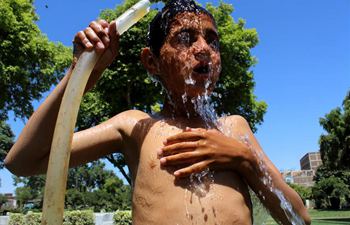MOMBASA, Kenya, Oct. 13 (Xinhua) -- Kenya is set to join countries in sub-Saharan Africa that have successfully eliminated elephantiasis (lymphatic filariasis-LF), the World Health Organization (WHO) confirmed on Thursday.
The debilitating parasitic disease can cause disfigurement of legs, arms and male sex organs and is rampant in remote and under-developed regions.
According to Sammy Njenga, Chief Research Officer at the Kenya Medical Research Institute (KEMRI), the parasite responsible for the disease is a thread-like worm that lives in the lymphatic vessels of humans.
But thanks to the Global Program to Eliminate Lymphatic Filariasis (GPEL) launched by WHO in 2000, there is a new hope of eliminating the disease which is classified as one of the neglected tropical diseases (NTD).
Togo, Burkina Faso, Benin, Ghana, Cameroun and Tanzania are among African countries that have successfully eliminated elephantiasis.
According to the WHO, over 120 million people are affected globally, with over 40 million of them seriously incapacitated and disfigured by the tropical disease.
WHO Country Representative in Kenya Rudi Eggers said the disease is endemic in the coastal region where about 3.7 million people are at risk of infection in counties of Mombasa, Kwale, Kilifi, Tana River, Lamu and Taita Taveta.
In remarks read on his behalf by WHO Disease Prevention and Control Officer Joyce Onsongo during the release of Dissemination of Lymphatic Filariasis Survey results in Mombasa, Eggers said an estimated 1 million Kenyans are already infected with the disease.
The survey was carried in all the six counties in the coast region by the Kenya Medical Research Institute (KEMRI).
"The goal is elimination of the disease by 2020 with the aim of first stopping the spread of the infection and to alleviate the suffering of the affected individuals," said Eggers.
"Fortunately, the disease can be eliminated by stopping the spread of infection through preventive treatment of all people living in endemic areas using safe medicine combinations, repeated annually for 4 to 6 years. Consequently, the disease is targeted for elimination as a public health problem by the year 2020," he said.
Ministry of Health Neglected Tropical Diseases Program Manager Sultani Matendechero was upbeat about meeting the elimination target by 2020 following the commitment of the Kenyan government, the WHO and other partners.
Matendechero said the program suffered setbacks leading to its collapse in 2011, a situation that he attributed to erratic funding.
"We restarted the program in 2015 after getting serious commitment for funding and steady supply of drugs for the mass drug administration from WHO and another donor called the End Fund," said Matendechero.
"Since the program was not consistent, the Kenya Medical Research Institute was tasked to do a survey in 2015 to enable the partners understand how much had been achieved and what needs to be done," he added.
The survey has also revealed that the widespread use of bed nets for malaria control has helped to keep the prevalence of elephantiasis low even when the community-wide treatments were skipped.
The ministry of health under the NTD program now has to increase effort in morbidity management especially surgeries for the enlarged scrotum on one hand and taking care of the swollen legs.

















